The majority of mental health specialists offering teletherapy services agree that they are an effective alternative to in-person therapy sessions. Online therapy accommodates more patients and provides them with easier access to various levels of mental health services, saves time and money, and helps practitioners maintain a work-life balance. Specialists that haven’t tried providing online therapy yet may wonder how to start a telehealth therapy practice feeling overwhelmed by the legal aspects, differences in patient management, and complex billing.
Let’s learn more about what any therapist should know before they start offering online services.
Operational aspects to consider before starting a private psychology practice
Before we start exploring the intricacies of teletherapy, let’s briefly overview what teletherapy is and how it’s provided.
Teletherapy is a way of conducting therapy that is based on telecommunication (including, but not limited to, communication, processing, and transmission of information through videoconferencing, audio, e-mail, chat, etc.).
Therapists can choose the mode of communication they deem best or mix them to get the results they need. For example, teletherapy might include videoconferencing as the direct service but also a chat function to keep in touch and ask questions that might be arising between the sessions. Depending on the therapist’s goals and chosen methods, the way of how to start a telehealth therapy practice might vary. However, there are still some general tips the therapist should consider before offering teletherapy services to their patients.
1. Choosing a software
The practice’s success depends a lot on the specialist’s skill. However, according to a survey by Sagepub, patients also indicate that the Internet connection stability and the teletherapy platform also impact their overall satisfaction with online therapy services.
Let’s explore what basic features your patients will expect to see within a teletherapy solution.
- Security. Patients need to know that their personal data and electronic health records are safe at all times and can be cleared at their request.
- User-friendly interface. An ideal interface doesn’t require effort to use or hours of onboarding.
- Must-have functionalities. The list might vary depending on the workflow chosen by the therapist. It might include self-scheduling and rebooking options, waiting lists, and online payment system integration. Ideally, the solution should be web-based so that it won’t require your patients to take any additional steps to install and update it, reducing the chance of any errors.
Explore what telepsychology solution features will help you start providing teletherapy-based services in our 12 Key Features to Look for in Telepsychology Software article.
2. Jurisdiction and licensing
The second important concern that many therapists have is teletherapy laws and regulations. The rules and policies for teletherapy across U.S. states. don’t match, so if you’re wondering how to start a telehealth therapy practice, you have to know for sure which legislation applies to you before actually starting out.
Starting a private psychology practice that will encompass multiple states is possible. Some states offer guest license provisions for up to 30 days in a year, making it easier for specialists to offer their services to those in need. You might also have to obtain an Interjurisdictional Practice Certificate (IPC) to get temporary permission to work with patients from other states.
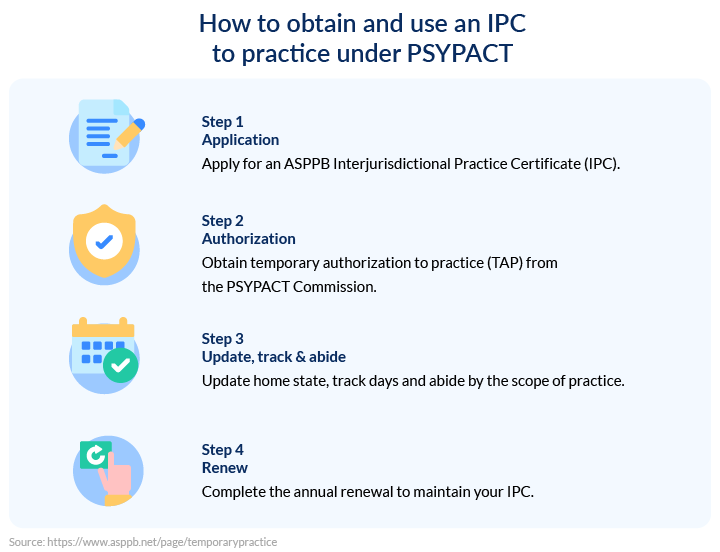
Additionally, to make sure your services are provided in accordance with all legal requirements, you need to:
- Retrieve an NPI number. If you have provided mental healthcare services before, you already have one. However, you need to make sure it’s within your reach at all times as you’ll need it to communicate to insurance companies and use a Superbill. If you are not sure where to look for your NPI, feel free to look it up here.
- Get liability insurance. You will need liability insurance to protect your professional services in case there is a claim or suit against you. Usually, therapists have to pay an annual fee; however, some companies provide discounts for specialists at the start of their careers.
- Correctly choose a business structure. You can offer your services as a Sole Proprietor, LLC, or S Corp. While being an LLC will generally protect you from personal liability, not all states allow you to hold this status. You should also keep in mind that it is easier and faster to register as a Sole Proprietor, changing this status at a later date.
- Get an EIN. If you’ve chosen to provide services as a sole proprietor, you can use your social security number as a business identification number to pay taxes and connect with insurance providers. However, to avoid using your social security number on any documents shared with your patients, you can get an EIN (it’s free) and use it instead in Superbill.
- Take care of taxes and accounting insurance. Consider what financial emergencies might happen, and get insurance. Check which taxes you have to pay, and learn about tax deductions.
- Follow ADA (Americans with Disabilities Act Standards for Accessible Design). There is a set of rules that ensure that software is accessible for patients with disabilities. Make sure the software you choose can be adjusted to be usable for all of your patients.
3. Office and supplies necessary for starting a private psychology practice
Once you’re all set up in terms of legislation, it’s time to think about the physical space you will use to provide online consultations. There are several points to consider when it comes to effective online communication if you intend to work from home or from your office.
Choosing equipment
Specialists looking how to start a telehealth therapy practice have to be sure that their hardware works properly. Make sure that your hardware works with the chosen software and that the drivers for output and input devices are installed.
The optimal setup for providing teletherapy consultations includes:
- a comfortable desk
- a chair with back support and height adjustment
- a working laptop that has a reliable battery
- a headset with clear sound
- organizers, a cable manager, office supplies, and a stand
- blinds for regulating window lighting
- lamps and extra lighting
Discover ways to organize your home office for effective work , and learn more about hardware options.
Reliable internet connection
One factor that might ruin your patient’s experience is an unstable Internet connection that leads to lags in video streams. To ensure you won’t have Internet issues, measure your Internet speed and check if it meets the requirements of the video conferencing solution you’ll use for teletherapy sessions.
Camera and microphone check
Before each session, check if your microphone and camera are working properly. You want to avoid situations where you are wasting your patient's time because you need to adjust your hardware.
Adjusting your office environment
Even if you work from home, you still have to organize your space to keep it professional.
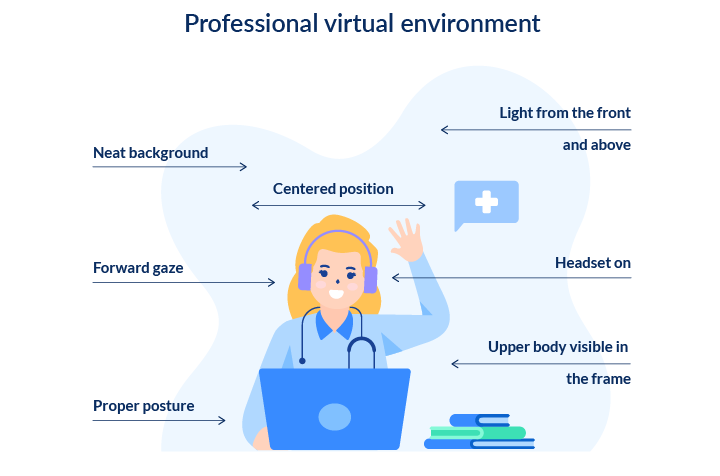
Try to follow these suggestions for the best results:
- a private space
- a clear background
- side and front lighting
- no visual and aural distractions
- clean and professional clothing
4. Patient management workflow for telepsychology
Every specialist wondering how to start a telehealth therapy practice has to think of the ways they can adjust an existing workflow to fit both their new needs and improve the patient experience.
Teletherapy solutions often offer patient management functionality that therapists can use to create such workflows:
- Patient scheduling. The scheduling function lets the therapist schedule a therapy session at the patient's request and may have the tools to reschedule appointments if needed. There are also some teletherapy solutions that offer automatic scheduling: if the therapist has a free time slot, the patient can book an appointment and pay for it online.
- Availability check. This option helps patients stay informed about the changes in your regular schedule and learn about your working hours so they can book an appointment that works for both you and them.
- Booking. Use this functionality to provide your patients with an easy booking experience. Some teletherapy solutions offer booking pages you can embed into your website, or you can link the booking option to your social media profile.
- Dashboard. This is a must-have functionality to access your patients’ data and manage custom fields. It collects and stores important information on prescriptions and notes about your patients’ progress.
- Online payment. This feature allows patients to pay for the sessions right away right from the platform they’ve used to book an appointment.
The teletherapy solutions market offers practitioners both software that includes all these features and standalone video conferencing tools that have integration options with third-party patient management platforms.
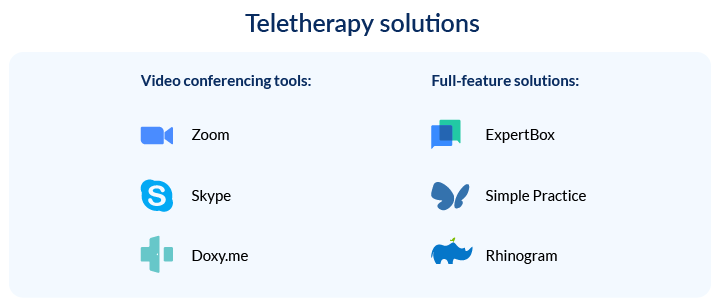
Keep in mind that practitioners who have been using a patient management platform for face-to-face therapy might already have a database of patients that needs to be transferred to another platform or updated with their online patients’ data. It is up to the specialist to find out which teletherapy solution option fits the practice better.
A high-quality patient management platform will let you stay in charge of your online practice. However, if you are concerned that some patient management systems do not provide secure integration with your chosen video conferencing platform, it is best to take a look at the teletherapy solutions that combine both video communication and patient management. If you choose an integrated solution, you won’t ever have to think about data security breaches or the lack of synchronization.
Want to compare the most popular teletherapy solutions before trying them out? Check out the overview of the top 10 telehealth platforms for therapists.
5. Work on effective communication
Virtual communication differs from face-to-face because it requires therapists to use different methodologies to capture patients’ attention and focus on the patient's tone of voice and facial expressions rather than body language. There are also specific requirements to be met by those starting a private psychology practice, like adjustment of the teletherapy session length to boost its effectiveness, or taking care of the privacy.
Telehealth visits may not be any longer than ten to fifteen minutes. So, establishing a rapport immediately is important.
When it comes to patients, teletherapy communication best practices include:
- ensuring the patient’s privacy
- using secure communication tools for sharing sensitive information
- ensuring the patient understands telehealth practice guidelines
- setting expectations
- building a rapport
- letting patients ask questions and listening to them
- avoiding examples from personal experience
Try to follow these best practices to improve your virtual sessions.
You also need to make sure your video conferencing solution is reliable. See if your video conferencing solution meets the requirements described in the image below.
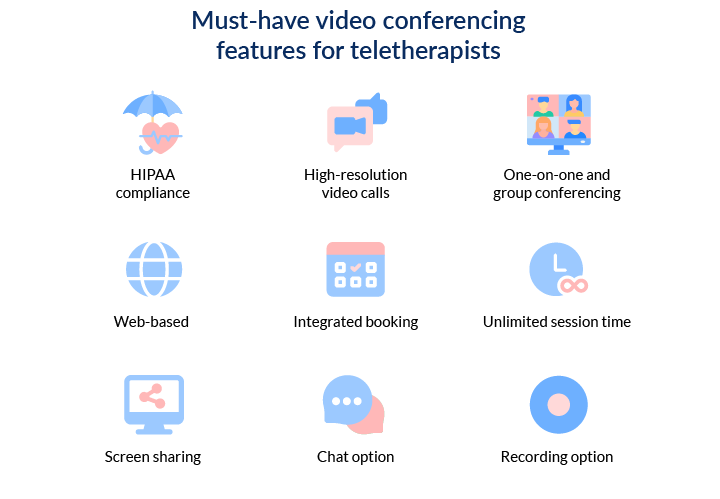
6. Keep patient notes
Keeping detailed notes of your patients’ progress has always been difficult for therapists who use traditional paperwork. However, teletherapy solutions offer a much easier approach to keeping all of your patients’ detailed information accessible. With the teletherapy approach, the practitioner can cut down the time usually needed for preparation because they have everything they might need on the platform.
Make sure to follow these recommendations for keeping and managing patient notes to make your work with patients easier:
- be clear, and do not use equivocal lexicon
- note the date and time of the patient’s visit
- avoid abbreviations
- try to avoid extra comments
- add chat transcripts
- use reports to analyze progress
Some teletherapy platforms already offer date and time information, store chat messages, and offer to add notes for each session, making it even easier for therapists to prepare. However, you have to ensure the solution you use for notes is HIPAA-compliant to avoid data breaches.
7. Implement smooth billing
As an online therapist looking how to start a psychotherapy private practice, naturally you would want to know how you will get paid for your services. You might ask yourself, how can I protect myself from the patients that skip visits and don’t provide their insurance information?
Don’t hesitate to communicate with your patients about billing matters and fees for each of your services (the video session, chat room, group services, etc.). Make sure to create terms of use with the description of each service. Also, make it clear to your patients what your payment policy is if the connection is interrupted.
If you offer multiple pricing options, ask your patient if everything is clear and answer any questions they may have concerning the services and what they include.
Teletherapy solutions often provide online billing methods that make payment easier for patients. You can also set up the system to charge patients before the session and add this as a requirement in your service agreement.
8. Take care of security
Thinking about how to start a telemental health practice, you want your patients to feel secure. This refers to the security measures you take to ensure their personal data and healthcare records stay intact and safe at all times. When you use a teletherapy platform, you depend on technology to protect your patients’ private information.
Because you rely so heavily on the teletherapy platform, you need to pay attention to the following factors when deciding which one is right for you:
- the platform is HIPAA-compliant
- user authentication is required to access ePHI records
- encryption protocols are used to protect your communication
- there were no data leak reports
- the platform allows you to remotely delete data at patient’s request
- there are regular security updates
You can always ask the support team to check if the solution provides these options or not.
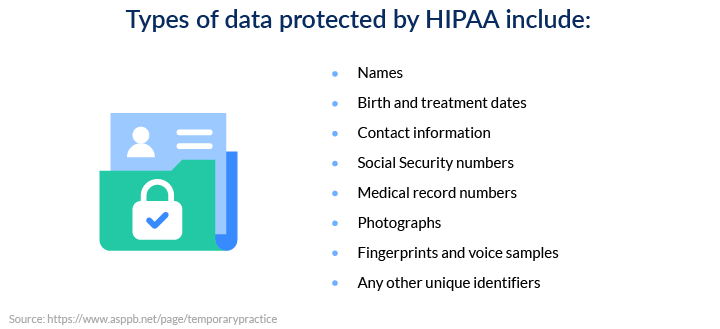
Also, make sure to use a unique password (ideally a generated one) and regularly change it to reduce any data breaches caused by human factors.
9. Create policies and documentation
Understanding what to include in your policies is perhaps the most confusing thing for an online therapist starting a private psychology practice. It’s important to not leave anything out because a carefully written policy explains to your patients their rights and the principles on which the therapy services are provided.
Another important matter that you have to resolve before you start providing services is receiving your patients’ informed consent to the terms on which the services are provided. To get your patients’ informed consent, you can use the intake forms and the service agreement features that some teletherapy solutions provide.
Let’s check what documentation and policies are required to start out as an online therapist.
HIPAA notice
According to the HIPAA Privacy Rule, online therapists, while being covered healthcare providers, have to provide a notice that clearly explains the patient’s rights, how their electronic personal health information is protected, and the practices used to ensure the patient’s privacy.
Tip: Make sure the HIPAA notice meets the notices of private practices (NPP) requirements.
Telehealth consent form
This form is used to get informed consent from your patient and should cover all the specific concerns that are related to the services you provide. Here you will have to unambiguously describe the services you provide in language that your patient will easily understand to avoid any possible discrepancies.
Consent to group therapy
If you plan on providing group therapy services, make sure your patients give you their consent before you start working with them. A consent to group therapy document might include a clear description of services, the group’s goals, the expectations, and a paragraph that addresses dropouts.
Authorization to exchange, obtain, or release information
Voluntary consent obtained from the patient is not enough for you to work with protected electronic health information. While the Privacy Rule permits you to get an informed consent document from your patient that regards the usage of health information needed for treatment, obtaining authorization to use electronic health information is mandatory.
An authorization form has to contain permission from your patient for you to use ePHI for payment acceptance, healthcare operations, and treatment purposes. If any part of the ePHI needs to be disclosed to a third party, that has to be specified as well.
Use an intake form to ensure you have obtained authorization from your patient before you start the session.
Attendance and termination agreement
This agreement specifies when and on what terms the services provision can be terminated. Here you can describe the definition of attendance and set a no-show policy that will include both urgent matters and unforeseen circumstances as well as payment and refunds.
Additionally, you can implement your payment policy.
Insurance verification form
An additional step that might save you time and reduce stress is to implement an insurance verification form that will provide you with all the patient’s information required to form an insurance claim.
Such forms should also address the following matters:
- the importance of consistently updating information
- the status of your patient’s insurance (it should be active)
After that, you can call the patient’s insurance provider and verify that the data matches with their database.
Tip: Make sure you have checked which payer you are working with before you submit a claim to ensure you have all the needed data. Insurance providers have varying requirements for claims.
10. Develop marketing strategy
Even if you only plan on providing teletherapy services, you still need to start marketing them before your actual work with patients starts. It takes time for the content on your blog to be indexed, and you won’t get thousands of followers on social media overnight, so you need to prepare your marketing strategy beforehand to make all of these channels work for you.
Let’s see what steps you should take to start marketing your services:
- Choose a niche. If you offer everything, then you offer nothing at all. Specify to whom you plan on providing your services. Concentrate on your potential patients’ concerns, and develop services that will match their needs.
- Build your brand. Decide on your tone of voice and the topics that will show off your skill and interest your target audience at the same time. Join other professionals’ podcasts and streams to let people know about you as an expert.
- Use an omnichannel approach. Make it easy for potential patients to find you and learn about your services on the web using paid ads, your personal website, social media profiles, and local listings.
Want to know how to increase the visibility of your services and grow your online therapy practice? Read our tips on how to market your private practice!
Final thoughts on how to start a telehealth therapy practice
Starting a private psychology practice requires preparation even from the most competent specialists. However, after you’re all set up, you won’t need to spend time digging into patient documentation and will have a workflow that will let you spend your time on actual work, not on appointment preparation.
FAQ
-
Starting a telehealth therapy practice involves several steps. Here's a general guide to help you get started:
- Understand the regulations and requirements
- Define your target audience and services
- Obtain necessary licenses and certifications
- Set up your workspace
- Choose a secure telehealth platform
- Develop policies and procedures
- Determine your fee structure
- Market your telehealth practice
Remember that the steps above provide a general framework, and it's important to consult with legal and professional experts in your jurisdiction to ensure compliance with local regulations and best practices.
-
Pay attention to these operational aspects before offering teletherapy services to their patients:
- Equipment reliability
- HIPAA-compliant software
- Secure office environment
-
Check what documentation and policies are required to start out as an online therapist:
- HIPAA notice
- Telehealth consent form
- Consent to group therapy (if applicable)
- Authorization to exchange, obtain, or release information
- Attendance and termination agreement
- Insurance verification form



